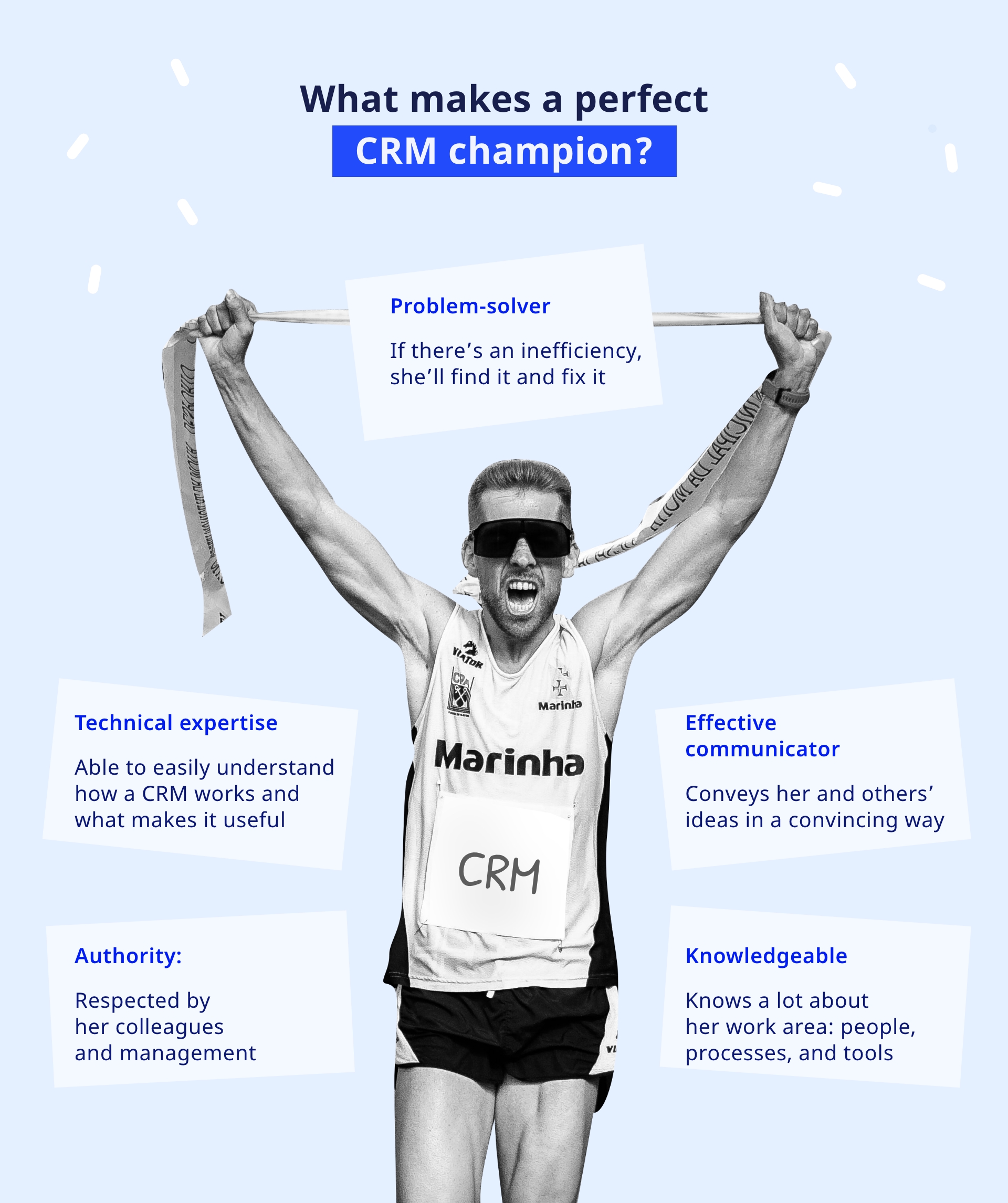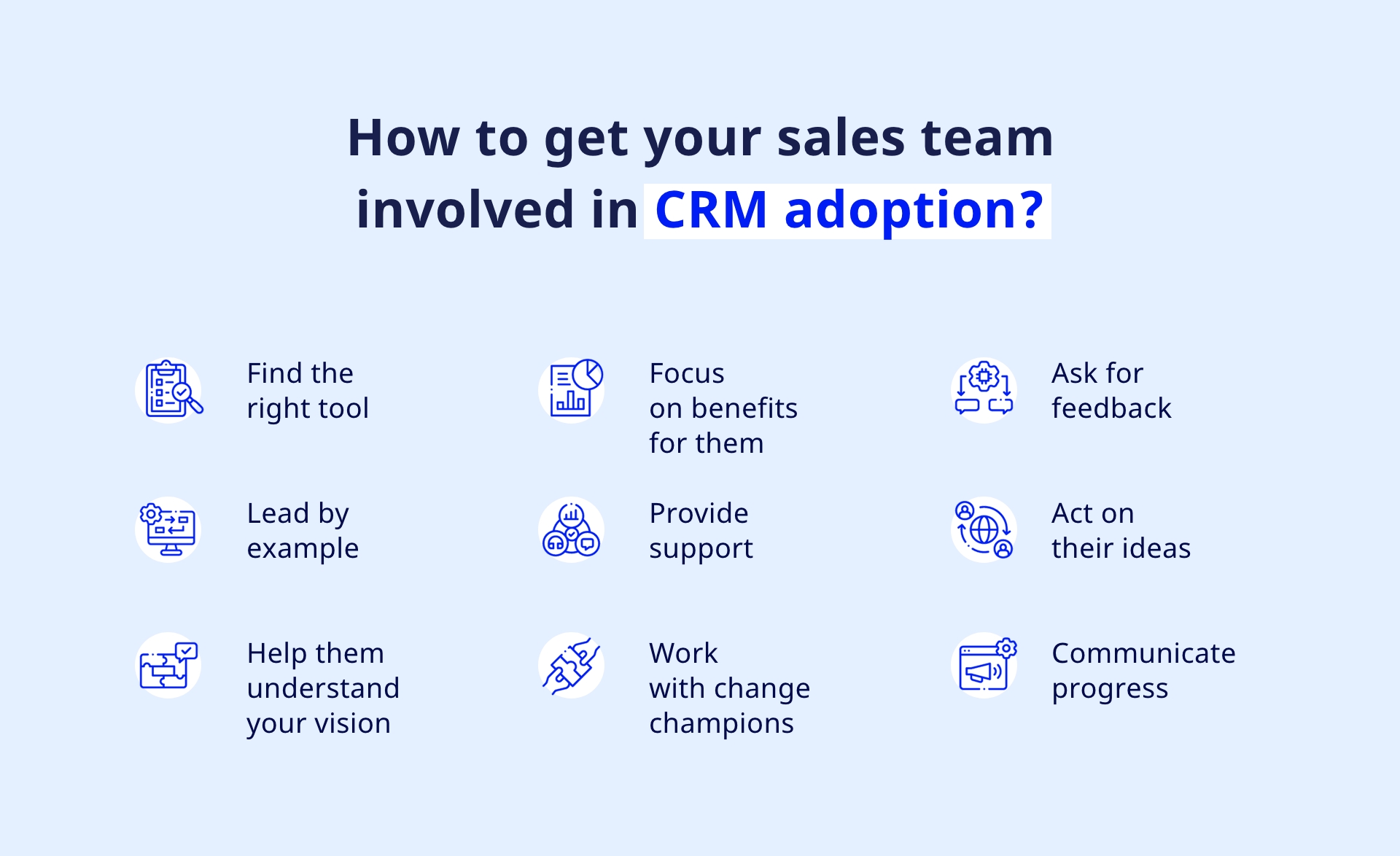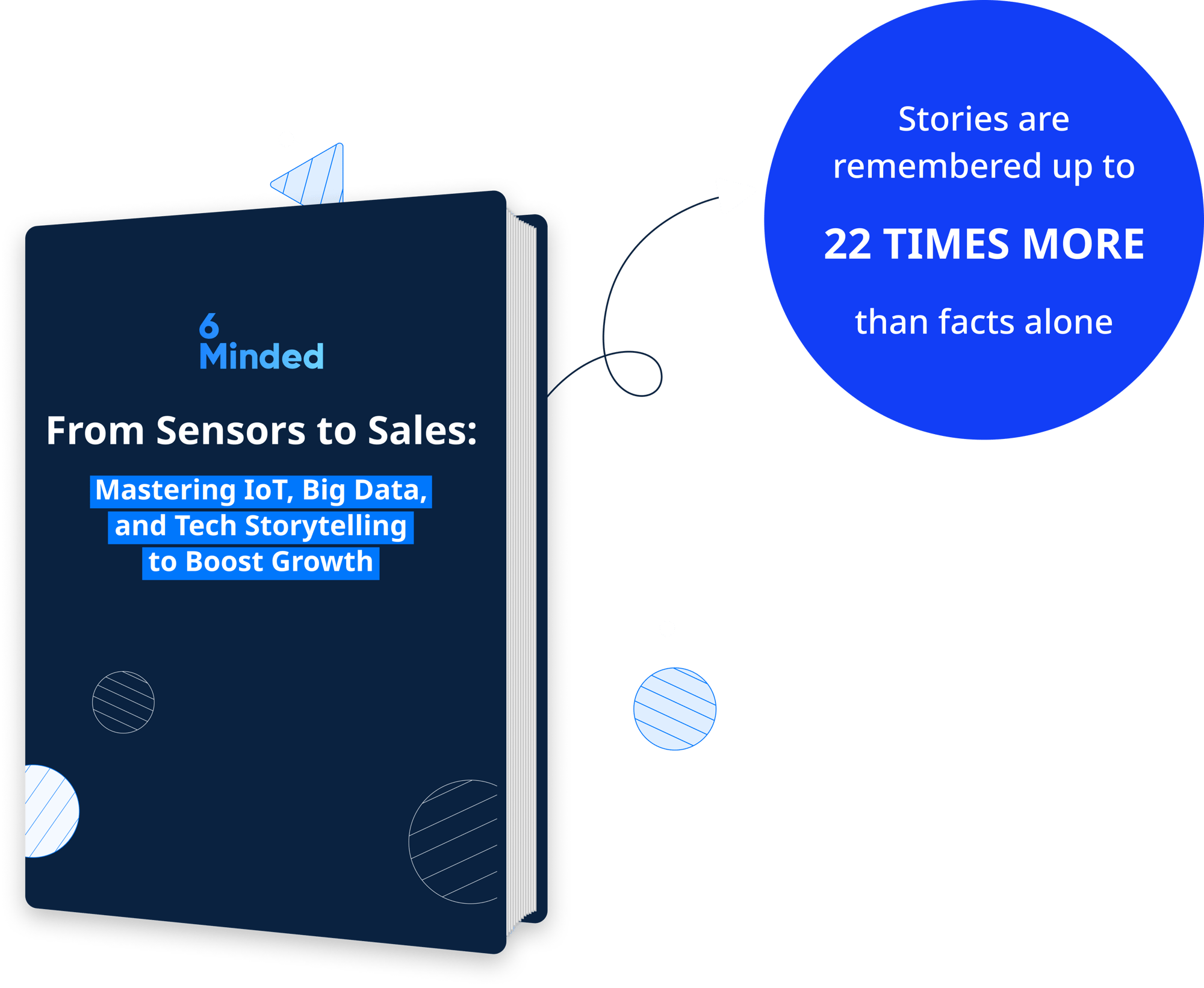As a business owner, you don’t need to be told twice how CRM can contribute to your company’s success. Streamlined operations, closer sales-marketing alignment, improved decision-making, cost-efficiency…
Now, say that to your sales reps. Do they share your enthusiasm?
According to HubSpot’s 2022 State of Marketing report, 1 in 5 sales reps doesn’t know what CRM is. And those familiar with the system may still fail to use it to its full potential, not only adding more complexity to sales processes and jeopardizing your business growth but also wasting money.
But the lack of understanding or training isn’t the only thing that may hinder smooth CRM adoption. Of all challenges of CRM implementation, users’ resistance to change is the most common, reported by 46% of small and medium enterprises.
22% of sales representatives do not know what Customer Relationship Management (CRM) software is.
[Source: HubSpot]
We know these problems all too well—we’ve faced them many times when implementing HubSpot CRM systems for our clients. One of them was a small company of just 15 people, some of whom were very hesitant to get on the new CRM. Eight years forward, our customer hires over 1,000 sales reps and operates in 6 countries. It wasn’t easy to get there, but it’s through cases like this one that we’ve learned how to overcome the challenges of CRM adoption.
So if you struggle to get full employee buy-in for successful CRM user adoption, this article is just what you need.
Why does your sales team resist CRM adoption?
Many sales teams have established workflows and tools they’re used to. Switching to a new system is a big step into the unknown that they feel may disrupt their everyday work. Sales reps may fear the new CRM will be difficult to learn and use, serve as a tool to spy on their work, or make them share information about leads with their colleagues (who may potentially steal them). Worst of all, they may oppose CRM adoption, assuming that benefits aren’t worth their time and effort.
The key to overcoming this resistance lies in understanding and addressing these fears. For that, managers need to empathize with employees and convince them that CRM adoption is a change for the better—not just for the company but for every sales team member.
CRM adoption — the first steps
That’s easier said than done. Don’t worry, though—with over 50 successful implementations under our belt, we have some handy tips for you.
Here’s the first one: start thinking about CRM user adoption early. You can do a lot to ensure employee buy-in before the CRM is even implemented.
Choose the CRM your sales reps will love to use
It’s your salespeople who’ll be using the CRM the most, so it’s crucial to find the one that suits them best. From our experience, we know that the two things that sales teams value the most are ease of use and practical features they’ll use daily. As a diamond-tier HubSpot partner, we honestly believe that HubSpot is the best CRM for both.
Your sales teams will be more willing to use a CRM that’s user-friendly + helps them achieve more daily.
The first reason for that is HubSpot’s holistic approach. Integrating sales, marketing, customer service, and the company’s website allows sales reps to track the entire customer journey easily. This makes day-to-day sales operations much smoother and enables individual sales reps to close more deals faster.
At the same time, HubSpot doesn’t try to replace every single business tool. Instead, you can integrate it with dozens of popular apps such as Gmail, Outlook, Office 365, Jira, Asana, and more. With that, your sales reps can use familiar tools from a single interface without juggling multiple browser windows.
HubSpot can be easily integrated with popular business tools such as Gmail.
[Source: HubSpot]
Regarding accessibility, HubSpot’s interface is intuitive, and the basic functions are easy to use from the get-go. Sales reps can access all hubs anytime, including contacts, content, or deals. Customizing essential features like analytics dashboards is done through drag-and-drop functionality and doesn’t require any coding skills.
All essential HubSpot features are available from its top bar.
[Source: HubSpot]
Last but not least, HubSpot provides your reps with a full toolkit of sales-oriented functionalities that expedite manual everyday tasks. Here are some of them:
- E-mail templates — Reps can save their best emails as templates and personalize, share, re-use, and optimize them through built-in reporting.
- Sales automation — With this, reps get a simple tool that handles essential but repetitive tasks like deal creation or follow-ups.
- Document management — Sales professionals can also create and update a sales content library and see how leads interact with every document.
HubSpot Sales features in action: e-mail templates, sales automation, and document management.
[Source: HubSpot]
Lead by example
Due to their complexity, CRM integrations are usually handled by external, specialist companies such as 6Minded. However, high-rank managers also have a part to play here: actively encouraging reps to adopt the new CRM.
External companies might not have the trust of rank-and-file employees. But if teams can see that the top management genuinely advocates a tool, that’s a different story. Even if the CEO and other executives won’t use CRM regularly, their honest involvement will prove its merit.
Joining a few key calls with CRM integrators is often enough to give the top brass a better understanding of day-to-day sales operations. These meetings are also a great opportunity for managers to show their involvement and explain the advantages of a new CRM from a business-specific perspective. However…
Focus on their benefits, not yours
…speaking of advantages, your employees want to hear about their personal benefits. Which features will reduce their manual workload? How can they use reporting and dashboards to get an instant view of their weekly activities and outcomes? Why auto-fill may prove critical to improving conversions? Focusing on specific benefits like that is what will make your sales teams tick.
And to provide a more tangible incentive, consider a small financial bonus for meeting a CRM-based KPI (such as a set number of emails sent or deals created). The goal is to encourage sales reps to use the tool, recognize them for doing that, and allow them to see its benefits firsthand. In our experience, it works every time.
Employee buy-in — after implementation
You’ve done it—your CRM is ready to use. And, if you’ve followed our advice, some of your employees are already on your side. Now, the real work begins.
To warrant an ROI, you need to convince your salespeople to use all relevant functions of the new CRM actively. Here, we also have a few hints to share.
Find a change champion
Most teams have high-performing and engaged members who are well-respected by their peers. They are the perfect fit for change champions: employees assigned to promote new workplace initiatives among their colleagues. Champions can do that thanks to their in-depth understanding of their area (like sales) and the respect and trust they enjoy from their peers.
A champion is a CRM evangelist, its best tester, a middleman between the devs and end-users, and a key figure in the CRM user adoption process. Through our experience, we’ve found that the best candidates for solution champions are tech-savvy sales reps who are open to new technologies and seek optimization opportunities. Ideally, they would also already have experience working with a CRM or a similar system.
These qualities will help them understand the new tool and its benefits and convince the rest of the team of its value. The champion should also actively collaborate with your implementation partner, sharing the inside knowledge of your processes to tweak the CRM to the needs of your sales team.

Ensure unconditional support
Resistance to change often comes from the effort it takes to learn a new tool from the ground up. We’ve seen some reps use a new CRM independently in a few days; others need months to master all features. Any learning curve is fine as long as you ensure good internal and external user support.
Internally, this means providing written instructions that will help users learn to navigate the CRM and find answers to common questions. It also helps to appoint an expert who’ll be able to solve other CRM-related issues. Usually, the best candidate is the point of contact with your implementation partner.
As for external support, this refers to all help provided by your CRM platform. Excellent customer service and self-help features are other reasons we’ve made HubSpot our chosen CRM. HubSpot offers assistance via email, phone, and chat. Additionally, its users enjoy access to a vast knowledge base and academy with courses covering topics from inbound methodology to all HubSpot modules. On top of that, the platform has an active and ever-helpful user community.
Stay open to user feedback and ideas
No one understands your users’ needs and grievances better than the users themselves. That’s why listening to both their criticism and insights is crucial if you want to create a CRM they will want to use.
Invite your salespeople to share their feedback through questionnaires or focus group discussions. New ideas are great, but criticism can be even more constructive. Make your survey anonymous so no one feels discouraged from challenging the change.

Finding improvements isn’t the only benefit of this approach—boosting your team’s morale is just as important. To achieve it, show that you’re interested in hearing out your employees, implement their ideas, and be vocal about it to encourage further feedback. Once your employees feel that they can impact the project, they will be more likely to participate actively. From there, it’s a straightforward way to CRM adoption.
Ensure CRM user adoption in your organization
Switching to a more efficient CRM can be a major milestone for your business. But for that, you need your salespeople to use it. With our tips, getting the buy-in will be much easier.
If you’re planning to implement a new CRM or change your current one, reach out to us and tell us about your business. We’ll tap into our experience to develop a CRM solution that both you and your sales team will love.



 September 2023
September 2023
